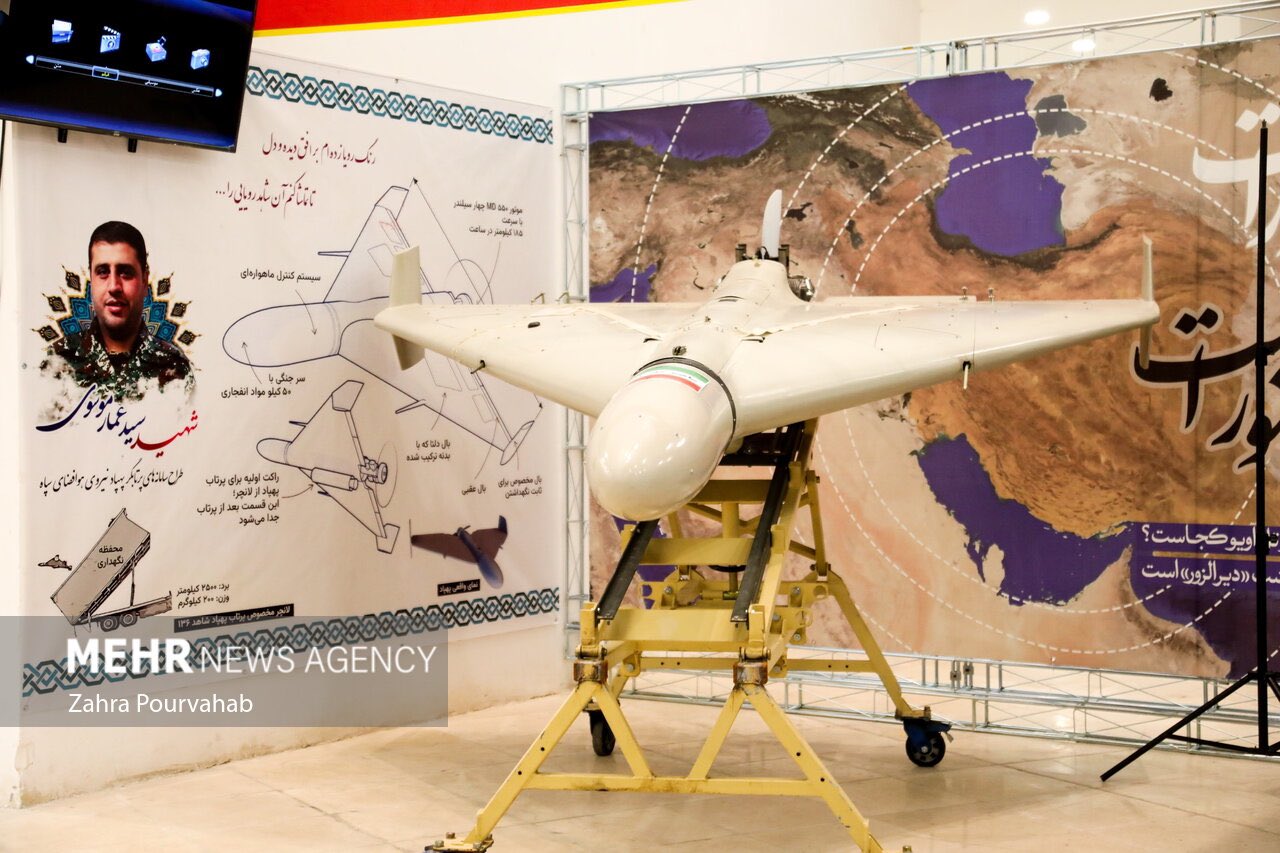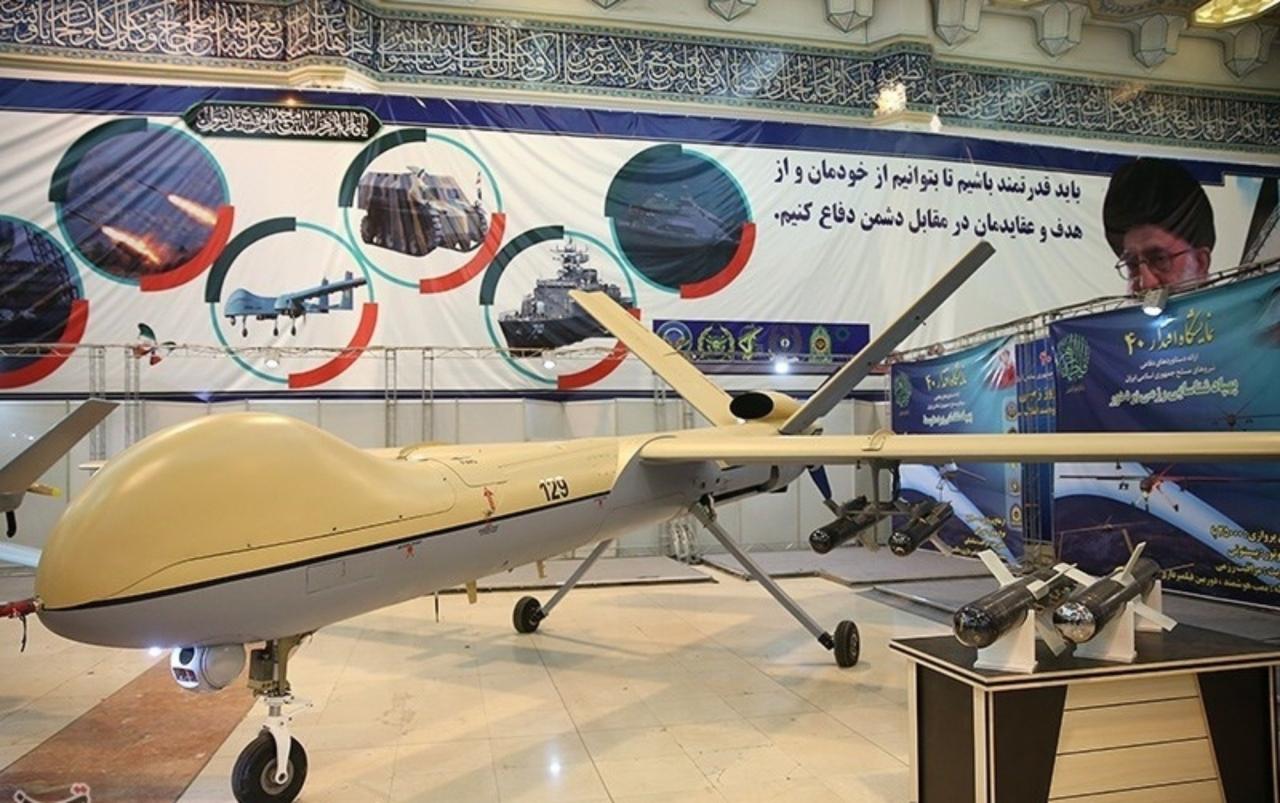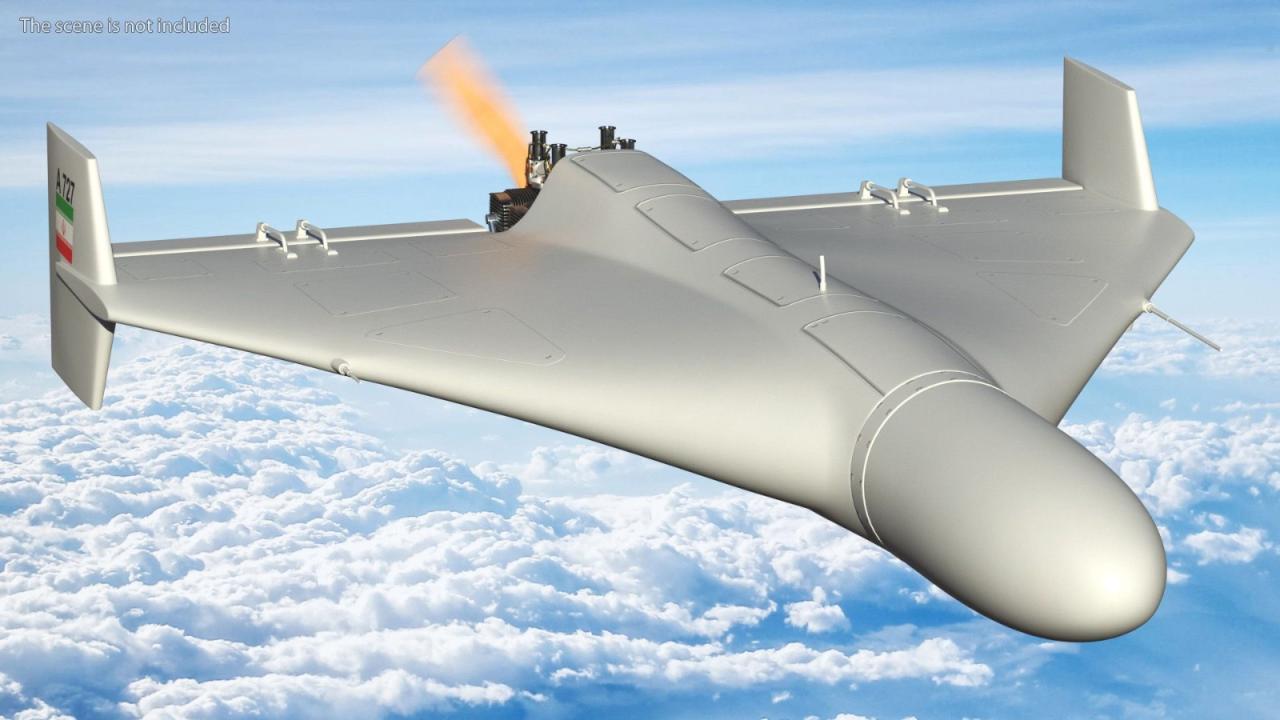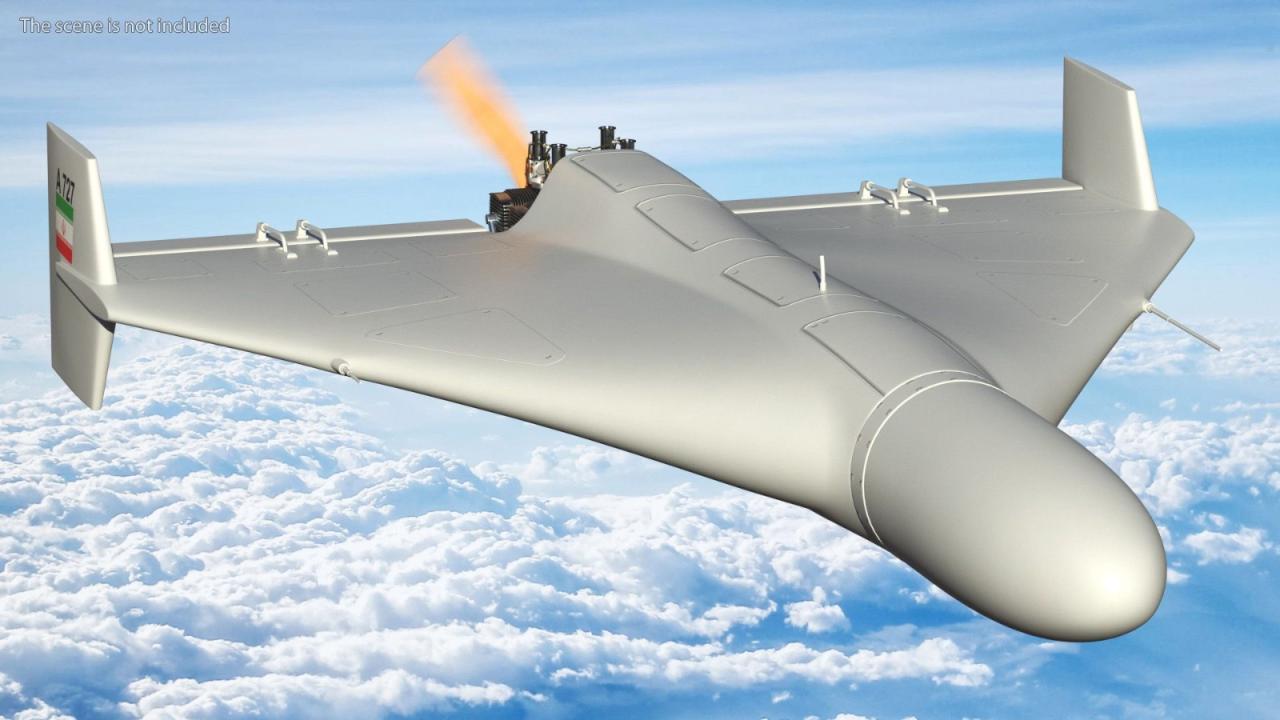Shahed drones, inexpensive and readily available, have fundamentally altered modern warfare. Their relatively simple design, coupled with their devastating potential for mass deployment, has sparked intense global interest and concern. This exploration delves into the design, operational capabilities, manufacturing, deployment, countermeasures, and the profound ethical and legal implications surrounding this game-changing technology.
From their origins and production processes to their tactical use in conflicts worldwide, we examine the Shahed drone’s impact on military strategies, international relations, and the very nature of modern combat. We will also consider future technological advancements and their potential implications.
Shahed Drone Design and Specifications
The Shahed drone, also known as the Shahed-136, is a low-cost, expendable unmanned aerial vehicle (UAV) designed for single-use attacks. Its design prioritizes simplicity, affordability, and ease of production, contributing to its widespread proliferation.
Key Design Features
The Shahed drone features a relatively simple airframe, utilizing a high-wing configuration for stability. Its design incorporates a small, turbofan engine for propulsion, and its overall construction emphasizes lightweight materials to maximize flight range and payload capacity within its cost constraints. The drone lacks advanced features commonly found in more sophisticated UAVs, such as sophisticated electronic countermeasures or advanced autonomous navigation systems.
Its design is optimized for its intended role: a loitering munition.
Size and Weight Comparison, Shahed drone
Compared to other similar UAVs in its class, the Shahed drone is relatively small and lightweight. While precise dimensions vary depending on the specific variant, it generally falls within a size range comparable to a small motorcycle. Its weight, including fuel and payload, is significantly less than larger, more complex military drones, making it easier to transport and deploy in large numbers.
Construction Materials
The Shahed drone’s construction primarily utilizes lightweight composite materials, such as fiberglass and carbon fiber reinforced polymers, to reduce weight and improve structural integrity. The selection of these materials contributes to its affordability and ease of manufacture.
Shahed Drone Specifications Comparison
A direct comparison with commercially available drones is difficult due to the classified nature of military specifications. However, a general comparison based on publicly available information can highlight its relative simplicity and affordability.
| Feature | Shahed Drone (Estimated) | Commercial Drone (Example: DJI Matrice 300 RTK) | Commercial Drone (Example: Autel EVO II Pro) |
|---|---|---|---|
| Wingspan | ~3.5m (estimated) | ~100cm | ~94cm |
| Weight | ~200kg (estimated) | ~3kg | ~1.2kg |
| Range | ~1000km (estimated) | ~15km | ~8km |
| Payload | ~50kg (estimated) | ~2.7kg | ~600g |
Operational Capabilities of the Shahed Drone
The operational capabilities of the Shahed drone are tailored to its role as a low-cost, expendable attack platform. Its features reflect a prioritization of simplicity and effectiveness in a single-use scenario.
Flight Range and Endurance
The Shahed drone boasts a significant flight range, estimated to be around 1000km, depending on the variant and payload. Its endurance is similarly impressive, allowing it to remain airborne for extended periods. This long range is a key factor in its strategic utility.
Payload Capacity and Types
The Shahed drone carries a high-explosive warhead as its primary payload. The weight of this warhead can vary, impacting the overall flight range and endurance. The design allows for relatively simple integration of the warhead into the drone’s airframe.
Navigation and Guidance Systems
The drone’s navigation system relies on a combination of inertial navigation and GPS. While not as sophisticated as those found in more advanced UAVs, this system provides sufficient accuracy for its intended mission profile. The relatively simple guidance system contributes to the drone’s low cost and ease of manufacture.
Communication Systems and Data Transmission
Communication systems are relatively basic, prioritizing reliability and simplicity over advanced data transmission capabilities. The communication link between the drone and its operator is designed for one-way communication, sending telemetry data back to the operator, but not receiving real-time commands.
Manufacturing and Production of Shahed Drones
The manufacturing process of Shahed drones is designed for mass production and cost-effectiveness. This emphasis on efficiency contributes significantly to their widespread deployment.
Key Components and Sources
The key components include the airframe, engine, navigation system, warhead, and communication system. Many of these components are likely sourced from various international suppliers, reflecting a strategy of leveraging readily available technology and minimizing reliance on highly specialized components.
Manufacturing Process
The manufacturing process is likely streamlined and automated to achieve high volume production. This involves a combination of automated assembly lines and human labor, focusing on efficiency and cost reduction. The simplicity of the design lends itself well to mass production techniques.
Estimated Cost of Production
The estimated cost of production for a single Shahed drone is relatively low, estimated to be in the range of tens of thousands of dollars, significantly less than more advanced military UAVs. This low cost is a crucial factor contributing to their wide availability and widespread use.
Potential Manufacturers and Entities

While precise details are often classified, various Iranian entities are likely involved in the design, manufacturing, and assembly of Shahed drones. Information regarding specific manufacturers and supply chains is often fragmented and incomplete.
Deployment and Tactical Use of Shahed Drones
The deployment and tactical use of Shahed drones reflect their design characteristics and cost-effectiveness. Their widespread use has significantly altered modern warfare tactics.
The Shahed drone, known for its inexpensive yet effective design, highlights the evolving landscape of drone technology. For those seeking a higher-quality, commercially available option with advanced features, consider the capabilities of the black falcon 4k drone canada , which offers significantly improved image resolution and flight control. In contrast to the Shahed’s often militarized applications, the Black Falcon is designed for civilian use, showcasing the diverse range of drone functionalities available today.
Deployment Scenarios and Strategies
Shahed drones are typically deployed in swarms or salvos, overwhelming enemy air defenses with sheer numbers. They are often launched from relatively simple, mobile launchers, allowing for rapid deployment and relocation.
Tactics Used in Attacks
The tactics employed involve saturating air defenses with a large number of drones, maximizing the chances of some penetrating defenses and achieving their objective. The drones are typically used in a one-way attack, impacting the target and then self-destructing.
Effectiveness Compared to Other Weapons Systems
While individually less powerful than more sophisticated munitions, the Shahed drones’ effectiveness stems from their numbers and low cost. Their ability to overwhelm air defenses and inflict damage at a relatively low cost presents a significant challenge to conventional warfare strategies.
Logistical Considerations for Large-Scale Deployment
The logistical challenges of deploying large numbers of Shahed drones are relatively manageable due to their small size and low weight. Their simplicity allows for easier transportation and deployment compared to larger, more complex UAVs. The ease of deployment contributes to their tactical flexibility.
Countermeasures Against Shahed Drones
The proliferation of Shahed drones has prompted the development and deployment of various countermeasures. These range from relatively simple techniques to sophisticated technological solutions.
Effective Countermeasures
Effective countermeasures include electronic warfare systems to disrupt drone communications and navigation, as well as kinetic weapons such as anti-aircraft artillery and missile systems. The use of directed energy weapons, such as lasers, is also being explored.
Technological Solutions for Neutralization
Technological solutions focus on disrupting the drone’s communication links, jamming its GPS signals, or physically destroying the drone with kinetic or directed energy weapons. The development of sophisticated AI-powered systems for drone detection and neutralization is also underway.
Defense Strategies Employed by Countries
Different countries employ various defense strategies, often combining multiple approaches. This includes early warning systems, integrated air defense networks, and the deployment of both kinetic and non-kinetic countermeasures. The development of layered defense systems is becoming increasingly important.
Hypothetical Defense System Against a Swarm
A hypothetical defense system against a swarm of Shahed drones would involve a multi-layered approach, incorporating early warning radar systems, electronic warfare systems for jamming and disruption, and a network of interconnected kinetic and directed energy weapons to engage and neutralize the drones. AI-powered systems would be crucial for coordinating the defense and prioritizing targets.
The Impact of Shahed Drones on Warfare

The widespread use of Shahed drones has profoundly impacted modern warfare, altering military doctrines and strategies, and raising significant political and economic consequences.
Strategic Implications of Widespread Use
The relatively low cost and ease of deployment of Shahed drones have democratized access to long-range precision strike capabilities, altering the strategic balance of power. This has implications for asymmetric warfare and the potential for escalation.
Impact on Military Doctrines and Strategies
Military doctrines and strategies are adapting to the threat posed by Shahed drones. This includes increased investment in air defense systems, the development of new countermeasures, and a reassessment of conventional warfare strategies.
Changes in the Nature of Modern Conflict
Shahed drones have changed the nature of modern conflict by making long-range precision strikes more accessible and affordable. This has led to an increase in the frequency and intensity of attacks, with significant implications for civilian casualties and infrastructure damage.
The Shahed drone, a relatively inexpensive yet effective weapon, has garnered significant attention for its use in various conflicts. Incidents like the one detailed in this report on a nj drone shot down highlight the growing concerns surrounding civilian airspace security and the challenges posed by such readily available technology. Ultimately, the proliferation of Shahed drones presents a complex challenge for international security.
Political and Economic Consequences of Proliferation
The proliferation of Shahed drones has significant political and economic consequences, including increased tensions between nations, arms races, and the potential for further destabilization of conflict zones. The economic impact includes increased military spending and the cost of developing and deploying countermeasures.
Ethical and Legal Considerations
The use of Shahed drones in warfare raises significant ethical and legal concerns, particularly regarding the principles of proportionality and distinction in armed conflict.
Ethical Implications

The ethical implications revolve around the potential for civilian casualties, the lack of human oversight in decision-making, and the potential for misuse of the technology. The ease of deployment and low cost raise concerns about the potential for indiscriminate attacks.
Legal Frameworks Governing Use
The legal frameworks governing the use of Shahed drones in conflict are complex and evolving. International humanitarian law, particularly the principles of distinction and proportionality, must be adhered to. The lack of clear legal definitions regarding the use of autonomous weapons systems presents a significant challenge.
International Humanitarian Law Implications
International humanitarian law requires that all attacks must distinguish between combatants and civilians, and that the expected military advantage must outweigh the potential harm to civilians. The use of Shahed drones presents challenges in ensuring compliance with these principles.
Key Ethical and Legal Challenges
- Potential for indiscriminate attacks leading to civilian casualties.
- Lack of accountability and transparency in decision-making processes.
- Difficulty in ensuring compliance with international humanitarian law.
- The legal status of autonomous weapons systems and the potential for escalation.
- The potential for misuse by non-state actors.
Technological Advancements and Future Developments
The technology underlying Shahed drones is constantly evolving, with potential for significant advancements in the future. These advancements could enhance their capabilities or lead to the development of entirely new drone technologies.
Potential Technological Advancements
Potential advancements include improvements in navigation and guidance systems, the development of more advanced communication systems, and the integration of more sophisticated payloads. The use of AI for autonomous operation is also a potential area of development.
Future Modifications and Improvements
Future modifications could include increased range, endurance, and payload capacity. Improvements in stealth capabilities and electronic countermeasures could also enhance their survivability. The integration of advanced sensors and targeting systems could improve their accuracy and effectiveness.
Potential for Future Technologies to Surpass Capabilities
Future drone technologies, such as those employing advanced AI, swarm intelligence, and hypersonic propulsion, have the potential to significantly surpass the capabilities of the Shahed drone. These advancements could lead to a new generation of autonomous weapons systems.
Timeline of Significant Advancements
| Date | Advancement |
|---|---|
| 2011 (estimated) | Initial development and testing of the Shahed-129 UAV platform. |
| 2019 (estimated) | First reported operational deployment of Shahed-136 drones. |
| 2022-Present | Widespread deployment and refinement of the Shahed-136 design. |
| Future (projected) | Integration of advanced AI and autonomous flight capabilities. |
The Shahed drone’s emergence signifies a paradigm shift in asymmetric warfare, challenging established military doctrines and prompting a global reassessment of defense strategies. Its affordability and ease of deployment have democratized access to powerful military technology, raising critical questions about international security and the ethical boundaries of modern conflict. Understanding the Shahed drone is crucial for navigating the complexities of contemporary geopolitical landscapes.
FAQ: Shahed Drone
How accurate are Shahed drones?
The accuracy of Shahed drones is debated, with reports varying. While relatively inexpensive, their accuracy is generally considered lower than precision-guided munitions.
What is the lifespan of a Shahed drone?
The operational lifespan of a Shahed drone depends on various factors, including usage and maintenance, but it’s generally considered to be limited.
Can Shahed drones be jammed?
Yes, electronic warfare systems, including jamming, can disrupt the communication and navigation systems of Shahed drones, making them ineffective.
Are Shahed drones easily manufactured?
While the design is relatively simple, the manufacturing process still requires specialized equipment and expertise, though it’s considered less complex than other sophisticated UAVs.
